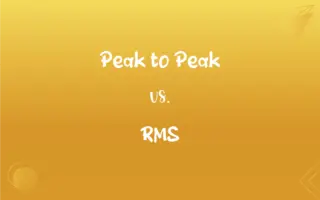Middle School vs. Junior High School: What's the Difference?
Edited by Aimie Carlson || By Janet White || Published on January 15, 2024
Middle school typically serves grades 6-8, focusing on a more integrated, holistic education, while junior high school usually covers grades 7-9, often with a subject-specific, departmentalized approach.

Key Differences
Middle schools generally cater to students in grades 6 through 8, serving as a transitional phase between elementary and high school. Junior high schools, traditionally, include grades 7 through 9, focusing more on preparing students for high school.
The middle school curriculum often emphasizes an interdisciplinary approach, integrating different subjects. In contrast, junior high schools typically adopt a departmentalized structure, similar to high school, with subject-specific classes.
Middle schools are designed to address the unique developmental needs of early adolescents. Junior high schools, on the other hand, are often more academically rigorous, emphasizing preparation for the more challenging high school curriculum.
In middle schools, students usually have the same group of classmates throughout the day. Junior high students, however, often move between different classes with different groups of students, similar to a high school setting.
Extracurricular activities in middle schools often focus on exploration and skill development. In junior high, these activities become more specialized, providing a foundation for high school level participation.
ADVERTISEMENT
Comparison Chart
Grades Served
Typically grades 6-8
Usually grades 7-9
Curriculum Approach
Interdisciplinary and integrated
Departmentalized and subject-specific
Focus
Transitional education, addressing developmental needs
Academic rigor, preparing for high school
Class Structure
Common group of classmates
Different classes with varied groups
Extracurricular Activities
Exploration and skill development
Specialized and foundational for high school
ADVERTISEMENT
Middle School and Junior High School Definitions
Middle School
A place where students explore various subjects and interests.
In middle school, he discovered his love for science.
Junior High School
A place for adolescents to develop specific academic and social skills.
She became more independent in junior high school.
Middle School
A school that bridges elementary and high school education.
Middle school helps students transition to high school.
Junior High School
A school focusing on more specialized, departmentalized education.
In junior high school, she excelled in math classes.
Middle School
An educational institution for early adolescents, typically grades 6-8.
She started attending middle school this year.
Junior High School
A preparatory stage for high school academics.
Junior high school introduced him to advanced science courses.
Middle School
An environment tailored to the developmental needs of young teens.
Their middle school has a strong counseling program.
Junior High School
An educational institution typically covering grades 7-9.
He will go to junior high school next year.
Middle School
A setting for students to develop foundational academic skills.
Middle school taught her essential study habits.
Junior High School
An environment where students start to experience a high school-like setting.
The junior high school has various sports teams.
Middle School
A school at a level between elementary and high school, typically including grades five or six through eight.
FAQs
What is a junior high school?
Junior high school usually refers to schools that serve grades 7-9, bridging the gap between elementary and high school.
What age are students in middle school?
Middle school students are generally between 11 and 14 years old.
What age are students in junior high school?
Students in junior high are typically between 12 and 15 years old.
What is a middle school?
A middle school is an educational institution that typically serves students in grades 6-8, between elementary and high school.
Are middle school and junior high the same?
Not exactly. While both serve early adolescent students, middle schools usually cover grades 6-8, and junior highs cover grades 7-9.
Can students choose electives in middle school?
It depends on the school, but many middle schools offer elective courses.
What is the focus of junior high school education?
Junior high focuses on preparing students for high school, often with a stronger emphasis on academic subjects.
Is the social environment different in middle school compared to junior high?
Yes, due to age and maturity differences, the social environment can vary between middle school and junior high.
How does the curriculum differ between middle school and junior high?
Middle school curriculum often integrates interdisciplinary learning, while junior high may start to specialize in specific subjects.
Are extracurricular activities different in middle school and junior high?
Yes, junior high schools might offer more advanced or varied extracurricular activities compared to middle schools.
Do middle schools have standardized testing?
Yes, middle schools typically have standardized testing to assess student progress.
Are electives more common in junior high?
Yes, junior high schools often offer a wider range of elective courses.
How does the transition to high school from middle school differ from junior high?
Middle school often focuses on holistic development for the transition, while junior high may focus more on academic preparedness.
Do junior high schools have more rigorous academic standards?
Often, yes. Junior high schools may have more rigorous standards in preparation for high school.
How do discipline policies differ between middle school and junior high?
Discipline policies in junior high might be stricter or more structured, reflecting the older age group.
What role do extracurriculars play in middle school vs junior high?
In both, extracurriculars play a crucial role in student development but may be more diverse and specialized in junior high.
What is the main purpose of middle school?
The main purpose of middle school is to provide a transition from the elementary level to the more challenging high school curriculum.
Is parent involvement different in middle school compared to junior high?
Parent involvement is generally encouraged in both, but the nature of involvement may change as students become more independent.
How does the teacher-student relationship differ in middle school and junior high?
In junior high, students may experience a more formal and academically focused relationship with teachers.
Are counseling services different in middle school and junior high?
Counseling in middle schools often focuses on personal and social development, while junior high counseling might focus more on academic and career guidance.
About Author
Written by
Janet WhiteJanet White has been an esteemed writer and blogger for Difference Wiki. Holding a Master's degree in Science and Medical Journalism from the prestigious Boston University, she has consistently demonstrated her expertise and passion for her field. When she's not immersed in her work, Janet relishes her time exercising, delving into a good book, and cherishing moments with friends and family.
Edited by
Aimie CarlsonAimie Carlson, holding a master's degree in English literature, is a fervent English language enthusiast. She lends her writing talents to Difference Wiki, a prominent website that specializes in comparisons, offering readers insightful analyses that both captivate and inform.








































































